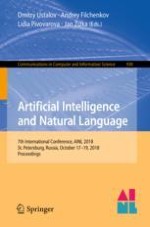2018 | Buch
Artificial Intelligence and Natural Language
7th International Conference, AINL 2018, St. Petersburg, Russia, October 17–19, 2018, Proceedings
herausgegeben von: Dmitry Ustalov, Andrey Filchenkov, Lidia Pivovarova, Jan Žižka
Verlag: Springer International Publishing
Buchreihe : Communications in Computer and Information Science
